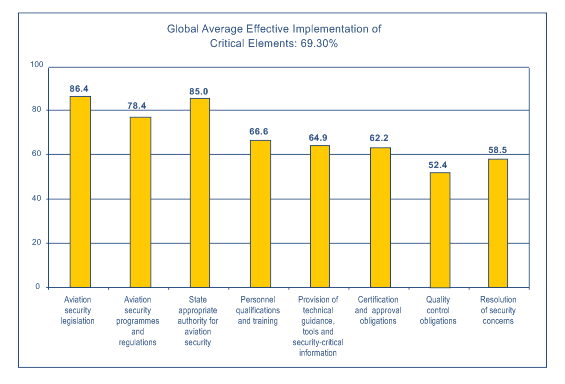Security Home
Universal Security Audit Programme
International Assistance and Cooperation
Aviation Security Training
Facilitation
Traveller Identification Programme (TRIP)
Technical Cooperation and Assistance Projects
The Universal Security Audit Programme (USAP) completed its second cycle of audits in June. Fifteen audits were carried out in the first half of the year, bringing the total number of second‑cycle USAP audits to 178, including an audit of a Special Administrative Region (SAR) of China. The global results from these audits are summarized in the graph shown below, expressed as the level of implementation of the critical elements of an aviation security oversight system.
As was the case in the first cycle of USAP audits, it was not possible to conduct second-cycle audits of all Member States. Some States could not be audited because of the security level assigned by the United Nations Department of Safety and Security (UNDSS); in other cases, an analysis of first-cycle audit and follow-up mission results, and/or review of corrective action plans (CAPs) and information supplied in pre-audit questionnaires, identified States that would benefit more from referral to the Implementation Support and Development – Security (ISD-SEC) Programme and appropriate assistance prior to an audit.
In addition to conducting audits, a USAP auditor and an ISD-SEC assistance coordination officer participated in a joint mission to Djibouti. ICAO missions were conducted in two Member States to validate actions taken to resolve Significant Security Concerns (SSeCs). Also over the course of the year, notice of two SSeCs involving one State was posted to the USAP secure website. By year end there remained seven unresolved SSeCs in four States.
Through the second half of 2013, the Secretariat focused on the transition of the USAP to a risk-based continuous monitoring approach (USAP-CMA). The USAP-CMA departs from the traditional notion of audit cycles in order to monitor Member States’ aviation security and oversight systems on an ongoing basis; the new process will still focus on identifying security concerns and making recommendations for their resolution, as well as providing enhanced feedback to States. The transition will continue throughout 2014, with full-scale implementation expected in early 2015.
Global Audit Results:
Level of Implementation of the Critical Elements of a Security Oversight System.

